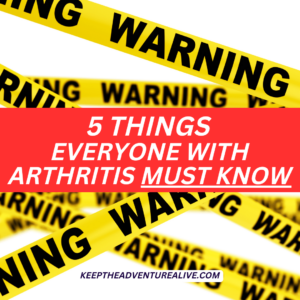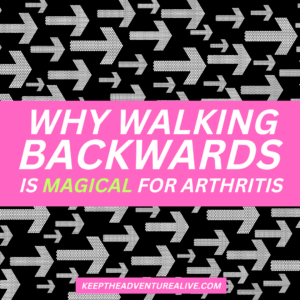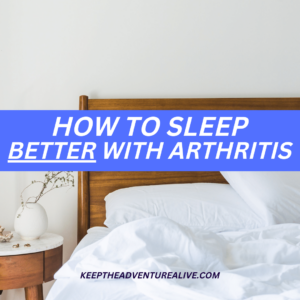When opting for a joint replacement surgery, it is important to know the top 5 mistakes after a knee replacement to make sure to avoid them. The goal in your recovery is to maximize success of the joint and help your body to heal optimally. As a physical therapist with extensive experience treating patients after total knee replacements, here are a few tips to help you through the recovery.
A knee replacement surgery is a big decision. Before making the decision it is incredibly important to weigh the pros and cons as well as how osteoarthritis is impacting your quality of life.
I have a post here dedicated to helping you make a confident and informed decision for yourself.
What to expect after a knee replacement
Post-operative rehabilitation and care of your new knee is incredibly important.
As a physical therapist, I spent years helping people heal after total knee and hip replacements, working in home health. I was able to learn a ton about the recovery process as well as find out what the common mistakes were along the way.
Some people do really well with joint surgery and others have a more difficult time.
This is why this article on what not to do after knee replacement is so important. Your actions after surgery can truly impact how your new joint heals.
Please note there can be adverse reactions to a knee replacement and this doesn’t mean you have done something wrong. With this surgery there is always risk for infection, allergy to implant, and other things that can happen that are out of your control.
What I want to show you today are the top 5 mistakes after a knee replacement that can potentially be avoided. Taking advantage of the things that are largely in your control can decrease your risk of adverse reactions and complications.
The reality is….if recovery is not followed appropriately- this scary fact keeps coming up:
"One yearafter TKA [total knee arthroplasty], patients report having greater difficulty with kneeling, squatting, moving laterally, turning, cutting,carrying loads, stretching, performing lower extremity strengthening exercises, playing tennis, dancing, gardening, and participating in sexual activity, when compared to healthy adults"
Bade et al 2010
But there is hope to return to these activities and actually enjoy them! Keep reading to find out how.
Top 5 Mistakes After a Knee Replacement to Avoid
Taking care of your new knee is crucial in order to get the outcomes you are likely searching for: reduced pain and improved mobility.
A knee replacement does not automatically result in pain relief so it is important to follow these guidelines along with the protocol of your surgeon for optimal healing.
This quote below is to help bring about the importance of post-operative care and dedication to this process.
Up to 30% of patients report dissatisfaction with the outcomes of their TKA [total knee arthroplasty] despite the absence of radiological or observable physical complications, such as infection or problems with prostheses. Patient dissatisfaction with TKA is higher when self-reported pain and functional outcomes do not improve or recovery outcomes do not align with preoperative expectations
Ditton et al 2020
Dedication to recovery can help you get the most out of your knee and start adventuring again!
Mistake 1: Not enough movement
Especially early on in the recovery process, sitting too much in one position with your legs hanging down can lead to ankle and foot swelling. When this happens, walking can become difficult.
After a total knee replacement, stiffness can come on rather quickly so it’s important to stay ahead of it.
Simple movements in a seated position or in a laying down position may be helpful earlier in recovery. Progressing to spending more time in standing is important as your joint continues to heal.
Movement will help to improve blood flow, reduce stiffness and heaviness of leg, and continue to improve range of motion.
When looking at what not to do after knee replacement, lack of movement is something you cannot afford to do if you want optimal results out of your new knee.
The goal is to move every 10-15 minutes if possible to prevent fluid from collecting in your joint.
As you progress into your recovery, stiffness may start to become less prevalent but frequent movement will be just as important.
Mistake 2: Resting your knee with a pillow underneath it
One of the most important aspects of recovery from a total knee replacement is restoring range of motion. Without appropriate knee bending and straightening, you may find activities like walking, stairs, and even standing are difficult to accomplish.
Placing a pillow underneath your knee can negatively impact your knee straightening ability. This is why it made the list of what not to do after knee replacement.
Resting for a while with your knee in a slightly bent position can make straightening your leg very difficult as your knee becomes stiff.
The best way is to support your entire leg with a pillow (such as a body pillow), not just underneath your knee. This will cause your leg to stay in a straightened position. See picture below.
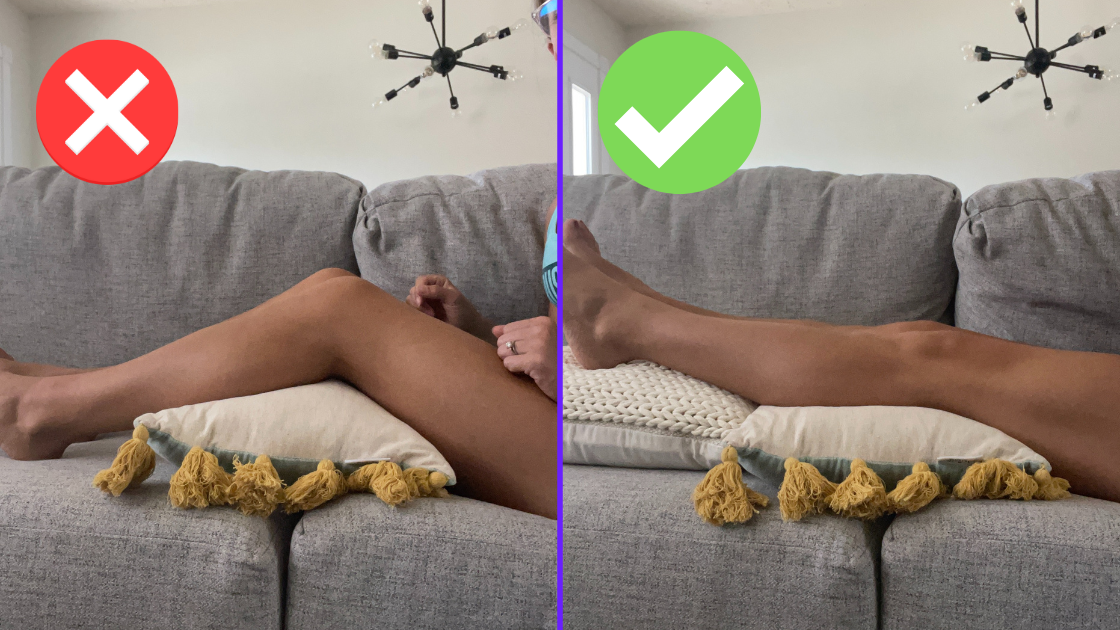
Mistake 3: Overdoing it right away
Trying to do too much right away can leave you with high levels of pain and swelling.
I met quite a few patients that felt good the day after surgery and started trying to walk without a walker, stand and resume normal tasks, and taking minimal rest breaks. This can lead to a significant increase pain up to days after.
Even if you are feeling good, especially in the first couple of days, allow your body to rest and recover. I would say this is arguably one of the most important of the top 5 mistakes after a knee replacement.
Doing too much right away can lead you down a pain hole that can be pretty difficult to climb out of.
As you move through the healing process, it is advised to increase your daily activity gradually- even if it feels good.
Split up daily tasks if you need to and make sure to take rest breaks in between, especially in the first 8-10 weeks. As you begin to feel more comfortable, you can start to do more including going out of the house for errands.
Keep in mind, everyone is going to heal a little differently so there isn’t a specific time point when you will be cleared for tasks like driving. It is based on how your knee is moving and your ability to react quickly if needed.
Mistake 4: Stopping Exercise Once Physical Therapy Stops
Truthfully, you will never be to a point in your healing where you won’t benefit from movement and exercise. Even without surgery, regular exercise is extremely important.
You will likely be discharged from traditional physical therapy (PT) once your pain is controlled and you can meet basic functional goals.
Rarely do people get to continue until they are able to do adventurous things like hiking, kneeling, higher impact exercise, squatting, etc. There are people who are years out from their replacement but don’t have the ability to squat and kneel like they want to.
Yes, I said kneeling. It can be possible even after a total joint replacement.
"There is currently no evidence that there is any clinical reason why patients should not kneel on their replaced knee, and reasons for not kneeling could be addressed through education and rehabilitation"
Wylde et al 2019
Take it from a member inside the signature membership, Adventurers for Life. Level 4 focuses primarily on gaining the strength and confidence for stairs and for kneeling. If you have the right movements to get you there, so much is possible.

One of the mistakes I see is that people tend to stop putting a priority on exercise once they have graduated from physical therapy. Exercise does continue to remain incredibly important especially if you have goals for adventure, for travel, or to return to activities you love.
The idea though is unfortunately not just continuing to follow the piece of paper you were given for the next 3 years. Instead, progressing exercise is extremely important.
Once out of PT though, many people feel lost with exercise. They may feel unsure what is safe and what should be avoided. Fear of re-injury can also play a part.
That is why I created the Adventurers for Life Membership program. If you want to be able to return to sports, be able to kneel, squat and use your knee without restriction- you have to continue to build strength, balance, and stamina- far beyond the initial PT you recieved.
Adventurers for Life is a great next step after you finish your physical therapy.
It walks you through step by step on how to regain your strength back starting with seated workouts and moving on up to using weights and even some higher impact activity once your body is ready.
There are current members of Adventurers for life who have gone through a knee replacement and are dedicated to getting the most out of their surgery so they can get back to a leading an active life- no matter if they are one year out or 5+ years out from surgery.
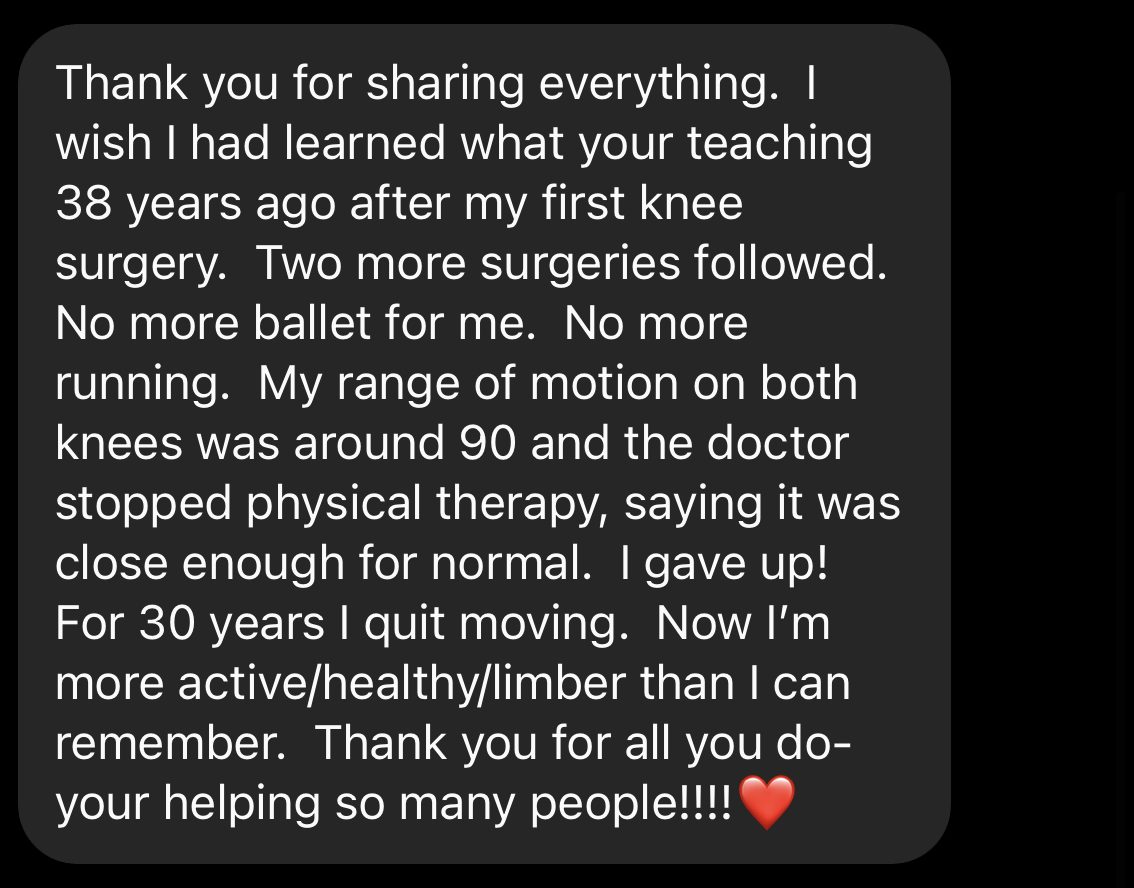
Mistake 5: Not fueling your body with the right foods
Food plays a vital part of recovery both right after surgery and with continued recovery down the road. What’s interesting is food is almost never discussed as a part of our traditional medical model.
Were you told that protein is incredibly important when it comes to aiding in wound healing?
Were you told that certain foods can increase inflammation and irritation inside of your joint- contributing to increased pain?
With osteoarthritis, it is so important to look at what you are eating and make sure you are fueling your body with the right foods. Prioritizing fruits, vegetables, quality protein sources, and other whole foods is incredibly important.
Most people are actually unaware that food does play a role in arthritis pain. Certain people may be more sensitive to food groups such as processed sugar and/or gluten but not everyone will be impacted in the same fashion.
That is why Adventurers for Life not only contains workouts, it also contains information on what foods to eat, how to prioritize protein and what to look for when grocery shopping to ensure you’re fueling your body in the right way.
Inside the membership you will find:
- Guest masterclasses on protein and supplements, anti-inflammatory cooking class and MORE
- Question and answer sessions with me along with monthly support groups to meet other members
- Anti inflammatory grocery list
And more!
Bonus Mistake 6: Trying to tough out the pain
When looking at what not to do after knee replacement- it is extremely important to discuss appropriate pain management.
Oftentimes I found people would try to wean off of pain relieving strategies too quickly. Pain can be intense, especially in the first few weeks, so it is important to make sure you get a handle on the pain as much as you can.
If you try to tough it out, you will find yourself digging a hole that becomes harder and harder to get out of.
Strategies such as: prescribed pain medications, frequent and gentle movement, icing, and the right amount of activity can help to keep pain at bay.
If pain levels get too high, motivation and willingness to move decreases and therefore brings on more stiffness. High levels of pain can also disrupt sleep which can actually make you more sensitive to pain- a vicious cycle you don’t want to be in.
As healing continues, you may continue to experience varying levels of pain which is why building appropriate muscle support and balance is extremely important. It is truly incredible how powerful movement and muscle strength can be for arthritic joints, even if they have been replaced.
Bonus Mistake 7: Giving up hope on your adventures
Just because you have had a joint replacement does not mean you have to set a low bar on what you can accomplish in the future.
Even outside of the top 5 mistakes after a knee replacement, this is equally as important!
You can relearn how to squat.
You can relearn how to get on the ground.
You can relearn how to go up and down stairs.
You can get back to traveling and walking longer distances.
These things are all possible with the right steps forward.
Making sure you have built adequate strength, maintain good range of motion and continue to improve your stamina- the world can be yours!
Don’t sell yourself short.
If you want to make adventure possible for yourself and feel your best after this surgery- Adventurers for Life is waiting for you.
Take a look at recent wins members have accomplished:





Conclusion
It is totally possible to have a successful knee replacement and be able to enjoy life. It’s important to know the top 5 mistakes after a knee replacement so you can do all you can to prevent them.
Recognize there are factors that are outside of your control but also that there certainly are factors that can increase your chance of success.
My ultimate goal is to help you get set up on the right path forward so you can make all of your adventures possible.
When looking at this list of what not to do after a knee replacement, don’t be overwhelmed. Keep in mind everyone’s progress may look different.
As long as you continue to try your very best to help your knee regain it’s function- these tips can help continue to guide you along this adventure.
Happy healing and see you inside Adventurers for Life!
Alyssa Kuhn

If you are looking to regain your active life but are unsure where to start, join the revolutionary membership, Adventurers for Life. This is a step-by-step path that not only will help you find pain relief but will help you unlock adventure. You’ll get workouts, tests to pass to make sure you are on the right track, community events and MORE.
References
Disclaimer: This post is for general informational purposes only. It should not be used to self-diagnose and it is not a substitute for a medical exam, cure, treatment, diagnosis, and prescription or recommendation. It does not create a doctor-patient relationship between Dr. Kuhn and you. You should not make any change in your health regimen or diet before first consulting a physician and obtaining a medical exam, diagnosis, and recommendation. Move Well Age Well, LLC and Dr. Alyssa Kuhn, PT, DPT are not liable or responsible for any advice, course of treatment, diagnosis or any conclusions drawn, services or product you obtain through this post, video or site. Complete all exercises at your own risk.

